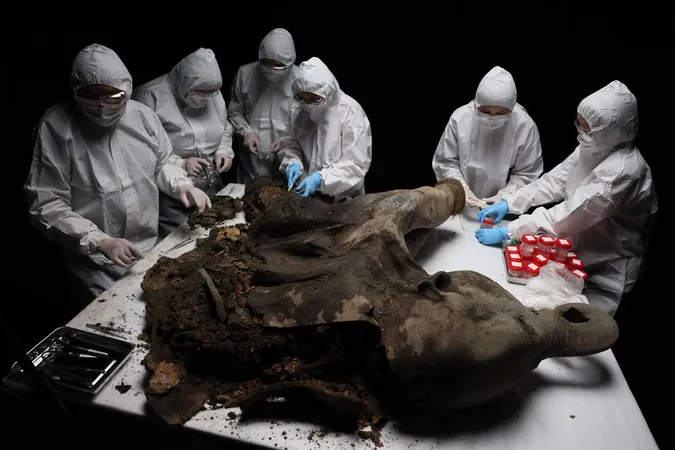
Scientists Dissect 130,000-Year-Old Baby Mammoth Named Yana: Unveiling Secrets of the Ice Age!
2025-04-04
Author: Yu
Unveiling Yana: A Remarkable Discovery
In a groundbreaking necropsy, a team of scientists has meticulously examined the body of Yana, a remarkably preserved baby mammoth that roamed the Earth around 130,000 years ago. Discovered in 2024 in the Siberian region of Sakha, Yana offers an unprecedented window into the prehistoric past, coinciding with significant climatic changes shaping the future of our planet.
Preservation and Examination
Residing in permafrost for millennia, Yana's well-preserved remains feature striking details: her greyish-brown skin, reddish fur clumps, and pronounced facial characteristics resemble those of modern-day elephants. Measuring 1.2 meters at her shoulder and weighing approximately 180 kilograms, Yana may very well be the best-preserved mammoth ever discovered, with scientists noting the retention of internal organs and soft tissues, which have largely evaded the relentless passage of time.
A Groundbreaking Necropsy
The necropsy, which took place at the Mammoth Museum in Yakutsk, involved a team of zoologists and biologists clad in sterile gear, laboring for hours to uncover vital information regarding Yana's biology and the environment she thrived in. Dr. Artemy Goncharov, leading the research, expressed that this exploration represents “an opportunity to look into the past of our planet.” He highlighted the investigation’s focus on identifying ancient microorganisms and analyzing the plant matter that had formed Yana's diet, providing insights into the ecosystem of her time.
Unlocking Secrets Through Diet
As the scientists proceeded with their analysis, they specifically noted that Yana's digestive tract remained largely intact. With her stomach and parts of the intestines available for examination, researchers could potentially unlock invaluable clues about extinct species' diets and health.
Impact of Climate Change
Yana's uncovering was propelled by alarming changes in climate, specifically the thawing of permafrost due to rising global temperatures. This phenomenon has sparked concern, leading scientists to study the implications of melting ice on both ancient life and contemporary health risks. Dr. Goncharov warned, “There are hypotheses suggesting that thawing permafrost may release ancient pathogens, with the potential to contaminate water and affect both plants and humans.”
New Insights on Age and Life
Interestingly, while Yana initially drew estimates of her death occurring around 50,000 years ago, further analysis has revealed she is, in fact, over 130,000 years old. Remarkably, signs indicate she lived past one year, as evidenced by her developing milk tusks, which are characteristic among young mammals.
Mysteries of Her Untimely Death
While the cause of Yana's untimely death remains a mystery, the environment of Yakutia during her lifetime was devoid of human presence, as humans are believed to have entered Siberia only 28,000 to 32,000 years ago. This time gap opens additional questions about the challenges she might have faced in her natural habitat.
Implications for the Future
This investigation serves not only as a time capsule revealing the mysteries of the Ice Age but also poses crucial inquiries about how modern conditions impact ancient remnants and what biological risks they may pose as glaciers continue to melt. The groundbreaking work being done on Yana emphasizes the urgent need for climate awareness as humanity navigates the historical lessons preserved in the ice.
Conclusion and Future Research
Stay tuned as we continue to uncover more about Yana’s life, the secrets of the Ice Age, and what her remarkable discovery tells us about our planet’s future!

 Brasil (PT)
Brasil (PT)
 Canada (EN)
Canada (EN)
 Chile (ES)
Chile (ES)
 Česko (CS)
Česko (CS)
 대한민국 (KO)
대한민국 (KO)
 España (ES)
España (ES)
 France (FR)
France (FR)
 Hong Kong (EN)
Hong Kong (EN)
 Italia (IT)
Italia (IT)
 日本 (JA)
日本 (JA)
 Magyarország (HU)
Magyarország (HU)
 Norge (NO)
Norge (NO)
 Polska (PL)
Polska (PL)
 Schweiz (DE)
Schweiz (DE)
 Singapore (EN)
Singapore (EN)
 Sverige (SV)
Sverige (SV)
 Suomi (FI)
Suomi (FI)
 Türkiye (TR)
Türkiye (TR)
 الإمارات العربية المتحدة (AR)
الإمارات العربية المتحدة (AR)